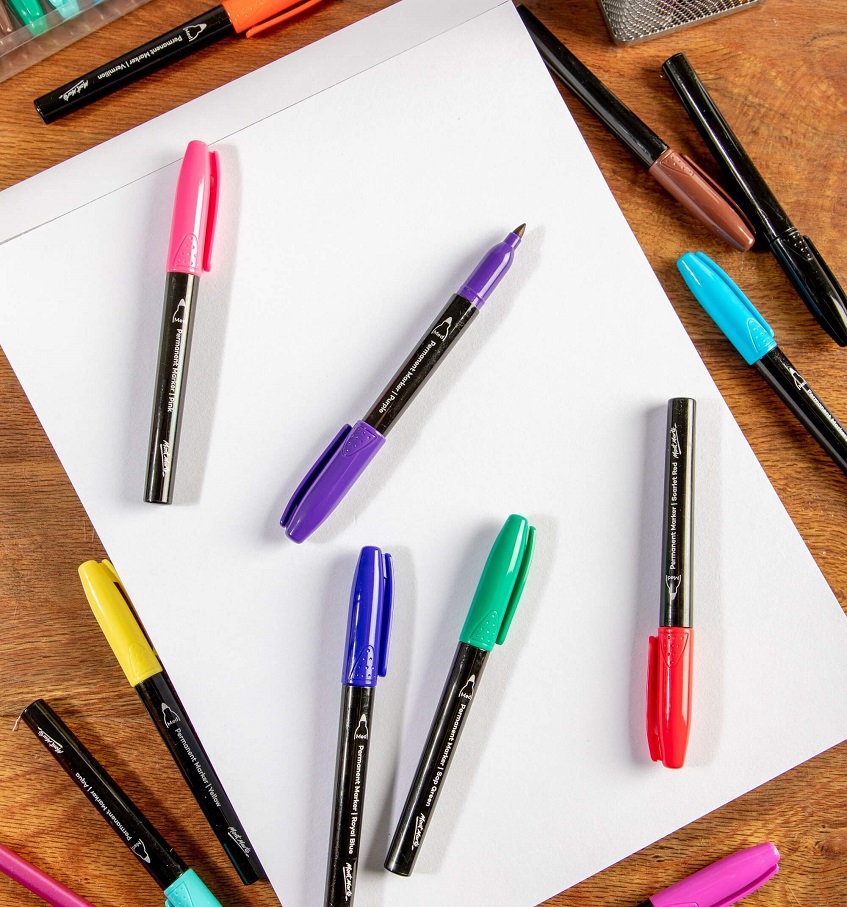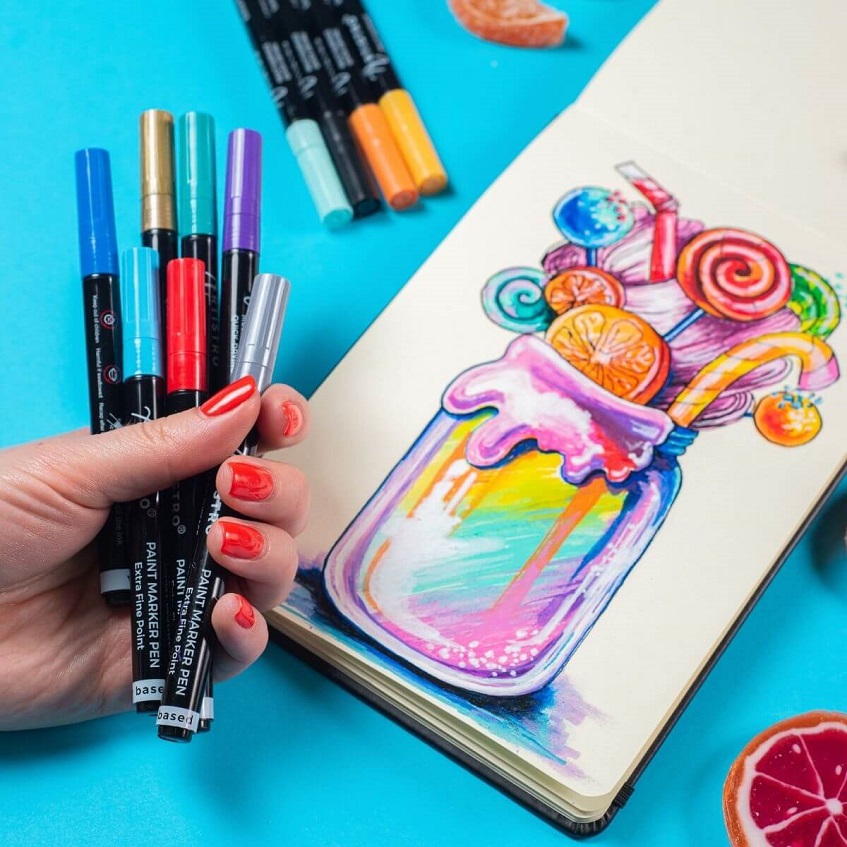
Acrylic Paint Pens: A Beginner’s Guide to the Different Types and Techniques
Embarking on the journey of artistic expression is an exciting venture for beginners, and the foundation of a well-rounded toolkit is crucial to unlocking one’s creative potential. Drawing supplies serve as the building blocks for artists. While encompassing a diverse range of tools, we shine a spotlight on the unique possibilities that arise when incorporating acrylic paint into the artistic range.
Contents
Introduction to Acrylic Paint
Acrylic paint, known for its vibrant colours and fast-drying nature, is a water-based medium that has captured the hearts of artists worldwide. Its pigment-rich composition delivers bold, opaque hues, allowing artists to create impactful artworks on various surfaces.
One of the defining features of acrylic paint is its versatility. Unlike oil paints, acrylics dry quickly, enabling artists to layer and work efficiently. The versatility of these mediums transcends conventional boundaries, allowing artists to unleash their creativity from paper and canvas to wood and fabric. One of the distinctive characteristics of acrylic pens in Australia is their quick-drying nature, setting them apart from traditional oil paints.
Types of Acrylic Paint Pens

When choosing professional art pens, consider the type of artwork you want to create and the level of detail you aim to achieve. The selection of pigmented and smooth-gliding acrylic paint pens Australia-wide encompasses various types, each offering a unique approach to artistic expression. Experimenting with different tip sizes and styles allows artists to discover the ones that best suit their artistic preferences and projects.
- Fine-tip Pens – fine, pointed tips, allowing for precise lines and detailed work. Ideal for intricate designs, outlining, and fine details.
- Medium-tip Pens – slightly broader tips than fine-tip varieties, balancing precision and coverage. Suitable for general outlining, colouring, and broader strokes.
- Broad-tip Pens – these models are designed for covering larger areas and bold strokes. Perfect for filling large spaces, creating backgrounds, and adding bold accents.
- Extra-fine-tip Pens – for extremely detailed and intricate work. Ideal for intricate patterns, small lettering, and highly detailed illustrations.
- Chisel-tip Pens – these options offer versatility in creating both broad and fine lines. Useful for various strokes, from broad colouring to angular detailing.
- Calligraphy Pens – designed for calligraphy, these pens have a unique tip shape to create varying line widths. Perfect for decorative lettering, script writing, and artistic calligraphy.
- Brush-tip Pens – have flexible tips that can produce variable line widths. Excellent for creating painterly effects, blending colours, and achieving a brushstroke-like finish.
- Metallic and Glitter Pens – infused with metallic or glitter pigments, they add a shiny and reflective element to the artwork. Ideal for adding accents, and highlights, and creating eye-catching details.
- Refillable Pens – can be refilled with acrylic paint, offering sustainability and prolonged use. These professional artist pens are suitable for those who prefer to use specific colours and want to reduce waste.
- Multi-surface Pens – designed to work on various surfaces, including paper, canvas, wood, metal, fabric, and more. Versatile options that are suitable for various artistic projects on different materials.
Choosing Acrylic Paint Pens
Choosing acrylic paint pens is crucial for bringing your artistic vision to life. Consider the tip size. Fine tips for detail and broader tips for coverage. Look for diverse colour ranges that suit your project and your preference. Consider the opacity for layering or solid coverage.
Decide between water-based or oil-based models based on your preference or your scheme. Check compatibility with your surfaces and drying time. Opt for refillable options for sustainability or disposable ones for convenience. Experiment with metallic or glitter options for added creativity and sparkle. Balance your budget with the set size, and start small to explore before committing to a collection.
Surfaces and Preparations for Acrylic Paint Pens

Acrylic paint is compatible with various surfaces such as canvas, paper, wood, fabric, and rocks. For canvases, it is crucial to prime the surface. Lightly sanding the canvas can enhance its texture, providing better adhesion for the paint. Paper surfaces should be heavyweight and designed for mixed media or acrylic applications. Consider using a drawing board or stretching the paper to prevent warping during painting.
When working on wood surfaces, especially unfinished ones, applying a clear sealant helps create a uniform base. Lightly sanding the wood can further smooth any rough surfaces. Fabrics should be washed and dried to remove sizing or impurities, and ironed to create a flat and smooth painting surface. For rocks, a thorough cleaning is necessary to remove any dirt or debris, and applying a base coat of gesso can enhance paint adhesion.
Before starting your project, conduct experiments on a small, inconspicuous area of the chosen surface. Allowing you to test the compatibility, assess colour vibrancy, and ensure proper adherence to the specific material. Additionally, consider the texture of the surface and how it might impact your artwork. Smooth surfaces allow for finer details, while textured surfaces can add character and depth.
After completing your artwork, you can apply a clear sealant as an optional step. It protects the surface and enhances the longevity of the paint. The choice of surface is subjective, and personalization plays a crucial role. But, before you even begin any of your projects, it’s important to know the best art supplies for beginners to start on your artistry journey.
Cleaning Tips
Cleaning might sound like a chore, but for your acrylic paint pens, it’s more like a spa treatment. Before they switch shades, let them enjoy a gentle wipe on a clean surface, shedding the residue of their previous art adventures. If one of your pens decides to take a creative siesta, get it back to life by pumping the tip on a scrap piece of paper. For stubborn, dried-up ink, use a lint-free cloth or a cotton swab dipped in water for a spa day detox, restoring your pen to its vibrant self.


No Comments